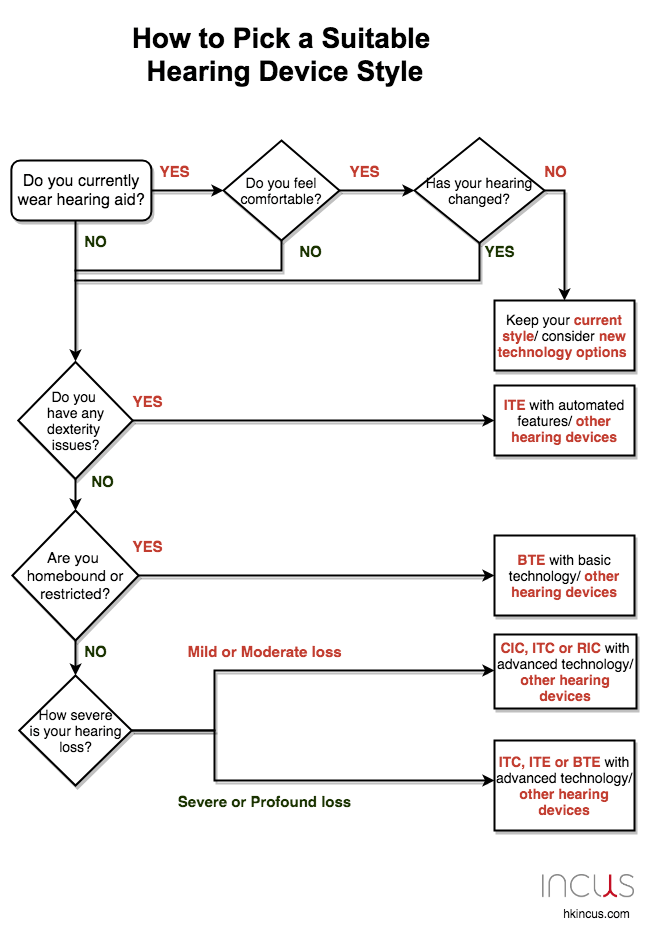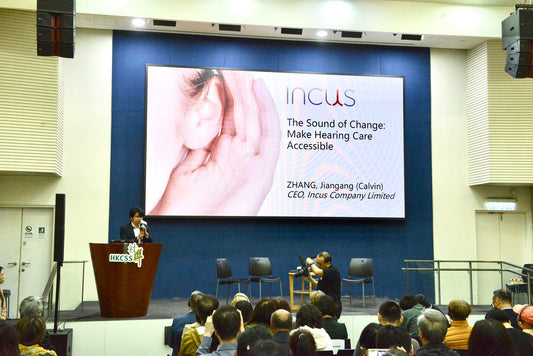Nowadays, there are many hearing aids in the market, with different styles and features. Buying hearing aids can be an overwhelming process full of abbreviations like BTE or ITC and feature names and technical terms like Wide Dynamic Range Compression (WDRC) or feedback management. This article introduces the top 6 most common hearing aid styles and choosing the most suitable type.

What Is the Best Hearing Aid Style?
Before introducing the most common hearing aid styles and the differences between them, we want to clarify: Is there an ideal hearing aid style?
The answer is no.
There is no ideal hearing aid style.
The reason why different styles exist in the first place is that people have different needs.
Here are some of the factors that influence the choice of hearing aid style:
- Hearing loss level and severity
- Speech recognition scores
- The anatomy of the ear
- Other health aspects, such as vision, dexterity and cognitive abilities
- Habits in daily life
- Familiarity with digital technologies like smartphones
- Budget
Those who have severe hearing loss may need to use one of the large hearing aid styles because smaller hearing aids are not loud enough.
The smallest hearing aid styles do not support Bluetooth, so they may not be suitable for someone who relies on streaming sounds from television and smartphone.
The Top Six Most Common Hearing Aid Styles
The top six hearing aid styles are BTE, RITE, ITC, IIC, CIC and other styles.
1. Behind-the-Ear (BTE) Hearing Aids

As the name suggests, behind-the-ear hearing aids hang behind the ear. The sounds produced by the device flow through an air tube into the ear.
Behind-the-ear hearing aids are the largest hearing aid style, so they have greater power, and are relatively easy to operate and adjust. They are suitable for people of all ages and a choice for people with severe hearing loss.
However, some may refuse to wear BTE hearing aids because of stigma, as they could be rather conspicuous.
2. Receiver in Canal (RIC) / Receiver in the Ear (RITE) Hearing Aids

This style is known as either receiver in the ear (RITE) or receiver in canal (RIC). The names essentially mean the same thing: an open-fit hearing aid style with the receiver (loudspeaker) built into an insertable ear dome. In other words, the loudspeaker of the hearing aid rests within the ear canal, while the microphone and processor sit in a tiny case behind the ear.
3. In-the-Ear (ITE) Hearing Aids

In-the-ear hearing aids are worn in the concha (ear bowl) and ear canal. They are customized to the physical shape of the ear. They come in different colours and can blend with the skin tone of the outer ear. Certain types of ITE hearing aids can penetrate deeper into the ear canal.
4. In-the-Canal (ITC) Hearing Aids

In-the-canal hearing aids sit in the lower portion of the outer ear bowl, making them comfortable and easy to use. They are slightly larger than IIC and CIC styles, so they tend to have longer battery life and fit a broader range of hearing losses. Their shape has space for features like directional microphones (for better understanding in noisy environments) and manual controls.
5. Invisible In the Canal (IIC) / Completely In the Canal (CIC) Hearing Aids

The invisible-in-the-canal (IIC) and completely-in-the-canal (CIC) styles are the smallest and most discreet hearing aids. They are worn deep in the ears, and they must be removed by tugging on a tiny pull-out string. CIC hearing aids are very similar but do not sit quite so deep within the ears.
These styles are typically fit for people with mild to moderate hearing loss.
6. Other Hearing Devices: Smart Personal Sound Amplifiers

Smart personal sound amplifiers are not hearing aids. However, like hearing aids, they are also capable of amplifying and personalising sounds. They are disguised as regular Bluetooth® earphones and can avoid the stigma associated with wearing traditional hearing aid styles. Some, who feel they are not ready for traditional hearing aids, choose to use the Kite 2 Smart Personal Sound Amplifier by Incus after learning how it compares to other hearing devices.
Smart personal sound amplifiers are easier to set up and use than hearing aids, and they can be set up from the comfort of one’s home. Their features are almost the same as hearing aids and in some cases more advanced.
Comparison of the Top Six Hearing Aid Styles
| Hearing Aid Style |
Suitable hearing loss level |
Advantages |
Disadvantages |
| BTE |
Mild to moderate |
Large and powerful Wide range of features |
Easily seen May cause occlusion |
| RIC/RITE |
Mild to moderate |
More discreet than BTE Own voice more comfortable because of open fit |
Easily affected by moisture or earwax Can be affected by earwax and moisture |
| ITE |
Mild to severe |
Custom fit to the ear Relatively long battery life |
May pick up more wind noise than ITC and IIC/CIC hearing aids May cause occlusion |
| ITC |
Mild to severe |
Custom fit to the ear Discreet |
May be difficult to use for those with reduced dexterity or vision |
| IIC/CIC |
Mild |
Custom fit to the ear Very discreet |
May be difficult to use for those with reduced dexterity or vision Short battery life |
| Smart personal sound amplifier |
Normal to severe |
Easy to handle and use Can be set up and adjusted at home |
Might not suitable for all level of hearing loss Not a medical device |
Flowchart: What is the Best Hearing Aid Style for Me?

Selecting and understanding what hearing aid is the right fit for you can be challenging. We created this flowchart to help first-time hearing aid buyers or individuals in the market for a new device figure out which hearing technology might be the best fit.
Do You Currently Wear Hearing Aids?
The best place to start if you are already wearing hearing aids is by evaluating how you feel about your current hearing aid style.
If you are happy with that style, you should be able to find a newer version with more modern features.
Your type and severity of hearing loss might have changed over time, so it is important to test your hearing before replacing your hearing aids.
Do You Have Problems With Dexterity?
If you have dexterity issues, it is usually better to avoid smaller devices. ITE, BTE or smart personal sound amplifier devices might be suitable because they are the largest and are simple to handle. It is worth considering hearing aids with automated features to avoid relying on tiny buttons to adjust the settings. Your hearing care professional might also recommend a remote control if the volume or program controls on your hearing aids are difficult to use.
Are Your Activities Limited?
BTE hearing aids or a smart personal sound amplifier might be suitable if you are homebound or suffer from cognitive impairment.
Depending on your situation, assistive listening devices like amplified telephones, special smoke detectors, bed-shaker alarms, doorbells that use flashing lights or a device to amplify the television may also be useful.
What Is Your Hearing Ability?
What kind of hearing loss do you have?
If you have hearing loss in both the low and high frequencies, the CIC or ITC styles will help process sound while still being quite discreet. The occlusion helps block out unwanted background noise.
RITE hearing aids may be a good option if your hearing loss is primarily in the high frequencies. The reason is that they let low-frequency sounds you are still able to hear naturally flow in (and out) of the ear while amplifying the high frequencies.
Severe-to-profound loss
If you have severe or profound hearing loss, ITC, ITE or BTE hearing aids might be suitable, depending on the degree of loss. These hearing aid styles provide the largest amount of amplification.
Do I Need a Hearing Aid?
The type and degree of hearing loss will influence whether a hearing aid is suitable for you.
You should see a hearing care professional or audiologist for a full evaluation of your hearing before deciding to get hearing aids.
The Bluetooth® word mark and logos are registered trademarks owned by Bluetooth SIG, Inc. and any use of such marks by Incus Company Limited is under license. Other trademarks and trade names are those of their respective owners.



